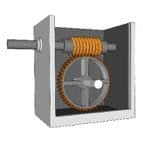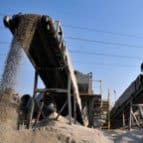
What is a Gear Reducer, anyway?
In the world of mechanical power transmission, there are a lot of moving parts, and things can get complicated quickly. A very important part of these systems are gearboxes – compound machines that transfer power from a prime mover to a load. Gear reducers are the primary focus of this article.

Of the six basic, simple machines, gearboxes typically utilize the Wheel and Axle and/or the Screw (worm reducer) to do work more efficiently by gaining a mechanical advantage. Motors are typically designed to operate at a specific “revolutions per minute” or RPM and, while this speed can be adjusted through the use of Variable Frequency Drives, in many cases it is more advantageous to use a set, specific gearing arrangement to adjust that output speed and thereby increasing torque.
For example, if a motor turns at 1800 RPM, and that motor is connected to a 10:1 gear reducer, the reducer will output 180RPM. If that same motor has a full load torque rating of 30 lb.ft., then the output from the 10:1 reducer (assuming an efficiency rating of 85%) will be 255 lb.ft. offering a significant increase in the amount of work that can be done. Common applications of this sort would be conveyors, where throughput capacity requires specific running speeds and increased torque to move materials from one location to another.
Where are gear reducers commonly found?

Gearboxes are found in all areas of industry – in aggregate processing, agriculture, chemical processing, oil and gas, transmission and distribution systems, logistics, warehousing, and storage to name but a handful. Gear reducers are commonly found in areas where higher torque and/or lower rotational speed is needed, or if power needs to be transmitted at an alternative angle, such as at a right angle to the motor. It is also possible to change rotational direction as well – clockwise vs. counterclockwise.
What can cause failure in a gear reducer?
Mechanical failures are a great concern with any application and is a topic of conversation and study that is commonly broached. When a system is not operating, it ultimately results in lost productivity, and by extension, money. Maintenance teams, line workers, and other staff are all working tirelessly to get the system back on-line as quickly as possible, and during this time, no product is being manufactured. So what causes failures? Like all rotating equipment, there are many potential reasons for breakdowns and downtime, but it usually comes down to one of two issues:
- Improper sizing or application
- Failure to maintain equipment
Breakdowns: Poor system design or specification
When it comes time to design a system with gear reducers, it’s important that the proper research, time, and care be given in the process. Choosing the wrong reducer, failing to take into consideration all requirements or operating environments, or under sizing a reducer to save a small amount of money in the short term are all potential pitfalls. Therefore, it is important to do proper research before installing an entire system! “You can pay me now, or you can pay me later” – it is far better to put the proper resources into your application at the start and be set up for far more longevity, than to have unexpected downtime later resulting in extreme loss of productivity and income.
Breakdowns: Failure to maintain
You wouldn’t buy a brand-new truck, drive it off the lot and say “this car is new. I’ll never need to change the oil,” would you? Of course not. Sure – for the first few months – perhaps even a year or so – everything would be fine. But eventually, that truck is going to need a new engine when parts start to warp, overheat, and wear out. Most gear reducers are the same – the oil within needs to be set to a specific level and needs to be changed regularly according to the manufacturer’s specifications. Every gear reducer should have a specified preventative maintenance plan in place, where the hardware is routinely checked for safe and correct operating conditions. Many companies also use automated systems to monitor the various parts of their applications, such as vibration sensors, or heat signatures, to give an early warning of problems that may appear.
Common questions regarding gear reducers
When it comes systems that involve gear reducers, there are two questions that commonly arise.
- “How do I select the best reducer for my job”
- “What I have now isn’t working well. How can I get a better system?”
Both questions come down to having someone with the right knowledge and experience assist you with building your ideal system. If you’re a distributor, we’d love to talk to you about your gear reducer needs, and if you’re in need of a distributor, we’d love to get you connected to one. Feel free to contact us at 1-800-808-2131 or on Facebook or twitter!
Gear reducers are complicated but choosing the right one doesn’t have to be. WorldWide Electric has a wide selection of quality, reliable, affordable gear reducers that will fit the needs of agriculture, aggregate, oil and gas, logistics, mining and more!
